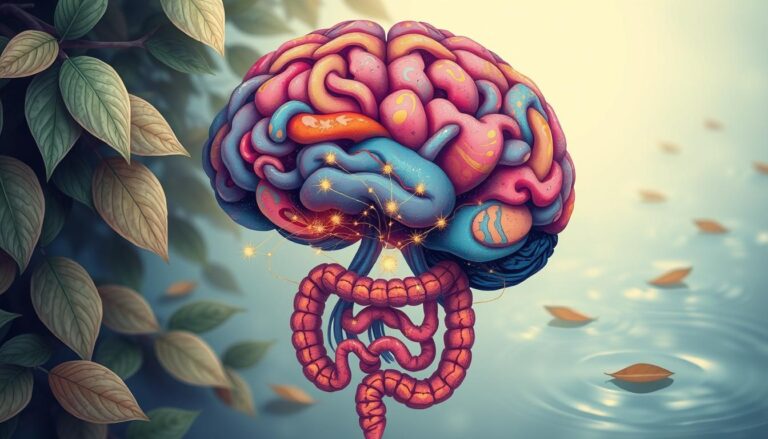Can mixing intermittent fasting with exercise really help you lose weight and get healthier? Studies say yes. This combo boosts fat burning, makes insulin work better, and improves heart health. Intermittent fasting can lead to a 1% to 4% weight loss in 1 week to 3 months. Exercise also releases happy hormones, which can lift your mood and reduce stress.
Research shows that those who fast and exercise see the biggest changes in body and heart health. So, what happens when you pair fasting with a balanced workout routine? This includes both strength and cardio exercises.
Key Takeaways
- Combining intermittent fasting and exercise can lead to significant weight loss and improved overall health
- Intermittent fasting can result in a mild body weight loss ranging from 1% to 4% over periods lasting from 1 week to 3 months
- Exercise releases endorphins, which can improve mood, reduce stress, and alleviate symptoms of depression and anxiety
- A well-rounded exercise program, including a mix of strength and cardio exercises, is recommended for optimal health and fitness outcomes
- Consulting a healthcare professional before significant dietary or exercise changes is wise, especially for individuals with underlying medical conditions or dietary restrictions
- Intermittent fasting and exercise can enhance fat burning, improve insulin sensitivity, and contribute to better appetite control and weight management
Understanding Intermittent Fasting Basics
Intermittent fasting means you only eat during certain hours each day. You can choose from alternate-day fasting or time-restricted eating. Knowing the different fasting protocols helps you pick the right one for you.
Some popular fasting protocols are:
- Alternate-day fasting: alternating between days of normal eating and days of calorie restriction
- Time-restricted eating: limiting eating to a specific window of time each day
- 5:2 diet: eating normally for 5 days and restricting calorie intake to 500-600 calories on the other 2 days
Research shows that intermittent fasting can help with weight loss. For instance, fasting for 12 to 14 hours can aid in weight loss. It’s important to find a fasting protocol that fits your lifestyle for lasting success.
Adding intermittent fasting to your daily routine can bring many health benefits. These include better heart health, physical performance, and obesity prevention. But, always talk to a healthcare professional before starting any new diet or fasting protocol, especially if you have health issues.
| Fasting Protocol | Description |
|---|---|
| Alternate-day fasting | Alternating between days of normal eating and days of calorie restriction |
| Time-restricted eating | Limiting eating to a specific window of time each day |
| 5:2 diet | Eating normally for 5 days and restricting calorie intake to 500-600 calories on the other 2 days |
The Science Behind Exercise and Weight Loss
Regular exercise is key for a healthy weight and better health. It works well with intermittent fasting to boost weight loss and health. The science is complex, but it’s clear that exercise is vital for reaching and keeping fitness goals.
Studies show that mixing intermittent fasting with exercise, like resistance training, helps keep lean mass. Exercise helps shift weight loss from muscle to fat when fasting. So, adding exercise to fasting means losing more fat and keeping more muscle.

Research found that exercise and fasting together lower body weight and BMI. They also reduce body fat and visceral fat. This shows that exercise with fasting can greatly improve fitness and weight loss goals.
Some main benefits of exercise and fasting together are:
- Improved weight loss results
- More lean mass retention
- Better fat burning
- Enhanced overall fitness and health
Intermittent Fasting and Exercise: The Perfect Combination for Weight Loss
Combining intermittent fasting with exercise can boost your metabolism. It helps burn fat and balance hormones. This combo can greatly improve your body’s shape and health.
Research shows that fasting makes your body use fat for energy during workouts. This can help you lose weight. Some studies found that fasting before exercise leads to more fat loss than eating first.
Metabolic Benefits of Combining Both Methods
Using both intermittent fasting and exercise has many benefits. It helps your body burn fat and keep muscle mass. This is key when you’re trying to lose weight.
Enhanced Fat Burning Effects
Studies show that women with obesity who fasted and exercised lost more body fat. They also saw better changes in lipid and glucose levels. This is compared to those who only did one of these methods.
Adding intermittent fasting and exercise to your routine can bring these benefits. It can help you reach your weight loss goals.
Timing Your Workouts While Fasting
When you’re doing intermittent fasting and exercise, when you work out matters a lot. You should fast for 16 to 18 hours to get the best results. Working out when you’re fasting can make your body produce more growth hormone if you don’t eat for two to three hours after.
Here are some key considerations for timing your workouts while fasting:
- Exercise early in the day to support the body’s natural circadian rhythm
- Refrain from eating for two to three hours after a workout to enhance hormonal benefits
- Start with shorter bouts of high-intensity exercise and gradually increase duration and intensity
Studies show that exercise and intermittent fasting together can help you lose more weight. This is because you lose fat but keep your muscle mass. Workout timing is key to getting these benefits. By following these tips, you can make the most of intermittent fasting and exercise for your health and fitness.

| Benefits of Intermittent Fasting and Exercise | Description |
|---|---|
| Weight Loss | Combining intermittent fasting and exercise can lead to significant weight loss |
| Improved Insulin Sensitivity | Intermittent fasting and exercise can improve insulin sensitivity and reduce the risk of type 2 diabetes |
| Increased Human Growth Hormone (HGH) | Exercising in a fasted state can lead to a rise in HGH levels, which can improve overall health and fitness |
Best Exercise Types During Fasting Windows
Choosing the right exercises during fasting windows is key. You want to pick low to moderate intensity workouts to keep your fast intact. Strength training, cardio, and high-intensity interval training (HIIT) are top choices. They help with weight loss and boost your health.
It’s important to listen to your body during fasting windows. Adjust your workout based on how you feel. For example, do strength training during your eating window if you’re fasting 16:8. Cardio and HIIT can be done during fasting, helping burn fat.
Strength Training Considerations
Strength training is great for building muscle and boosting metabolism. During fasting, stick to lighter exercises and avoid heavy weights. You might want to do strength training after eating to support muscle growth.
Cardio Exercise Guidelines
Cardio is excellent for health and weight loss. In fasting windows, try walking, jogging, or cycling at a low to moderate pace. Remember to stay hydrated and listen to your body to avoid too much strain.
High-Intensity Interval Training (HIIT)
HIIT is fantastic for weight loss and heart health. In fasting windows, try sprints, burpees, or jump squats. Start slow and increase intensity to avoid overdoing it.
Exercising during fasting can burn more fat, improve insulin sensitivity, and boost autophagy. Always talk to a healthcare professional before starting new exercises or fasting plans, especially if you have health issues.
Maximizing Muscle Gain While Fasting
Intermittent fasting and exercise together can boost muscle gain and health. This combo leads to better body shape and health. But, most studies focus on losing fat, not gaining muscle.
Still, research shows fasting helps keep muscle when losing weight. For example, alternate-day fasting with cardio keeps muscle mass. It’s key to add resistance training to grow muscle, especially when dieting. Protein intake is crucial for muscle growth, aiming for 0.6–0.9 grams per pound of body weight.
Some key tips for gaining muscle while fasting include:
- Eat about 1.6-2.2 grams of protein per kilogram of body weight during eating times to avoid losing muscle
- Do resistance training to keep lean mass by boosting growth hormone levels
- Time meals around workouts for best muscle gain results while fasting

By mixing fasting with strength training, you create a great environment for muscle growth. This combo leads to more fat loss and keeps lean mass. With the right strategy, you can see big improvements in your body and health.
Nutrition Strategies for Fasted Exercise
Proper nutrition is key for fasted exercise. It supports your workout and fuels your body right. Think about your nutrition plan for pre-workout, after, and staying hydrated.
A good nutrition plan helps you power through fasted exercise. It supports your health and fitness goals. Focusing on the right nutrition boosts your fasted exercise results. For instance, the right pre-workout nutrition prepares you and keeps your energy up.
- Drink plenty of water during fasting
- Use electrolyte supplements to avoid imbalances
- Plan a post-workout meal for muscle recovery and growth
By using these nutrition strategies, you can support your health and fitness goals. You’ll get better results from your workouts. Always listen to your body and adjust your nutrition plan as needed.
| Nutrition Strategy | Benefits |
|---|---|
| Pre-workout nutrition | Supports energy levels and workout performance |
| Post-workout meal planning | Supports muscle recovery and growth |
| Hydration guidelines | Helps to prevent dehydration and support overall health |
Common Challenges and Solutions
When you mix intermittent fasting with exercise, you might face some common hurdles. These include managing energy, preventing muscle loss, and dealing with hunger. Understanding these issues and finding ways to solve them is key.
Some people find it hard to have enough energy because of fasting. But, you can adjust your fasting times to fit your needs. Drinking water and eating foods rich in electrolytes can also help keep your energy up.
Managing Energy Levels
- Eat nutrient-dense foods during your eating window
- Stay hydrated by drinking plenty of water
- Consider incorporating electrolyte-rich foods or supplements
Another challenge is preventing muscle loss. This can be solved by eating enough protein and doing resistance training. This way, you keep your muscles strong and healthy.

Dealing with Hunger
Hunger is a big challenge for those fasting. To beat it, stay busy and do things that take your mind off hunger. Drinking water or black coffee can also help curb hunger and cravings.
Safety Considerations and Precautions
When you mix intermittent fasting with exercise, it’s key to think about safety considerations. This ensures you get the most benefits without risking injury or illness. Always talk to a healthcare professional before starting any new diet or exercise plan, especially if you have health issues.
Some people might need to be extra careful, like those with diabetes, a history of eating disorders, or pregnant or breastfeeding women. It’s also vital to listen to your body and tweak your routine if needed to avoid any negative effects.
Here are some important safety considerations to remember:
- Drink plenty of water before, during, and after exercise
- Watch how your body reacts to intermittent fasting and exercise, and make changes if needed
- Don’t push yourself too hard, especially when starting out with exercise and intermittent fasting
By following these safety considerations and precautions, you can reduce risks and enjoy the benefits of intermittent fasting and exercise for your health and well-being.
| Health Condition | Safety Precautions |
|---|---|
| Diabetes | Consult with a healthcare professional before starting any new diet or exercise program |
| Pregnancy or Breastfeeding | Avoid intermittent fasting and exercise unless under close medical supervision |
| Eating Disorders | Avoid intermittent fasting and exercise unless under close medical supervision |
Creating Your Personal Fasting-Exercise Plan
Combining intermittent fasting with exercise is key to reaching your health goals. You need to plan your fasting times, workouts, and track your progress. A good plan keeps you focused and maximizes your fasting and exercise benefits.
First, think about your lifestyle and what you like when picking your fasting schedule. The 16:8 method is popular, but you can try different times to see what fits you best. Choose exercises that fit your fasting times. For example, do yoga or walk when fasting, and save intense workouts for eating times.
Determining Your Fasting Schedule
Adjust your daily routine to fit intermittent fasting. You might need to change meal times, workout plans, and sleep. Listen to your body and adjust as needed. If fasting makes you weak or dizzy, it’s time to rethink your plan.
Designing Your Workout Routine
Choose exercises that match your fasting schedule. HIIT is great for non-fasting times, while yoga or walking works for fasting. Mix cardio and strength training for fitness and weight loss.
Creating a personal plan is about finding what works for you. By planning your fasting, workouts, and tracking progress, you can reach your health goals. Intermittent fasting and exercise help you take charge of your health and make lasting lifestyle changes.
Conclusion: Maximizing Your Results with Intermittent Fasting and Exercise
The mix of intermittent fasting and exercise can lead to amazing weight loss and health gains. Studies show it can cut down body weight, boost insulin sensitivity, and even help with diabetes.
By following the tips in this article, you can create a plan that fits your needs and goals. It’s important to be consistent and patient. Making these changes takes time, but the benefits are huge.
The combination of intermittent fasting and exercise is a strong way to maximize results. It’s great for losing weight, improving metabolic health, or boosting overall well-being. Start your journey, listen to your body, and see how this powerful mix changes your life.





